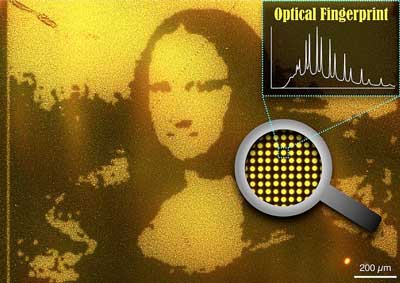| May 26, 2020 | |
High-security identification that cannot be counterfeited(Nanowerk News) Try whispering at one end of the Echo Wall in the Temple of Heaven in Beijing. People at the far end of the curved wall will still hear you, from 65 meters away. This is the whispering-gallery effect. Now, researchers from Japan have used the underlying principles of the whispering-gallery effect to stop counterfeiters in their tracks. |
|
| High-security identification should be exceptionally resistant to counterfeiting. Unfortunately, identity thieves eventually learn how to duplicate even highly complex patterns. The only way to permanently defeat identity thieves is to create a pattern that is impossible to duplicate. | |
| In a study published in Materials Horizons ("Optical microresonator arrays of fluorescence-switchable diarylethenes with unreplicable spectral fingerprints"), researchers from the University of Tsukuba used whispering-gallery waves to create a pattern that cannot be duplicated. In so doing, they created a new, impenetrable anti-counterfeiting system. | |
 |
|
| Researchers from the University of Tsukuba create millimeter-size chips with unique color patterns that cannot be forged. | |
| "Instead of using sound waves, we used light waves to follow the concave surface of micrometer-size dye particles," explains Professor Yohei Yamamoto, senior author of the study. "This creates a complex color pattern that cannot be counterfeited." | |
| To create their millimeter-size microchips, the researchers first deposited small dye particles, where fluorescence from the particles can be turned on and off. They then selectively lit up the chip in a defined pattern; regions of bright particles, and regions of dark particles. | |
| Each dye particle has a unique diameter and shape. Because of the principles that underpin the whispering-gallery effect—in this case, light instead of sound—the fluorescence emitted by each particle is unique. This creates a unique color pattern, a fingerprint, across the microchip that is impossible to reproduce or forge. | |
| "We attained a pixel density of several million per square centimeter on our optimized microchips," says Professor Yamamoto. "We have developed a high-security, two-step optical authentication system: the micropattern itself, and the underlying pixel-by-pixel fluorescence fingerprint of the microchip." | |
| The researchers used their technology to create a millimeter-size approximation of the Mona Lisa. This approximation contains a unique, embedded fluorescence fingerprint that cannot be duplicated. | |
| Businesses, governments, and many other organizations require unambiguous authentication that cannot be forged. By using a microchip that is impossible to counterfeit, high-security organizations have a new option for preventing fraud, ensuring secrecy, and vouching for the integrity of data and equipment. |
| Source: University of Tsukuba | |
|
Subscribe to a free copy of one of our daily Nanowerk Newsletter Email Digests with a compilation of all of the day's news. |
